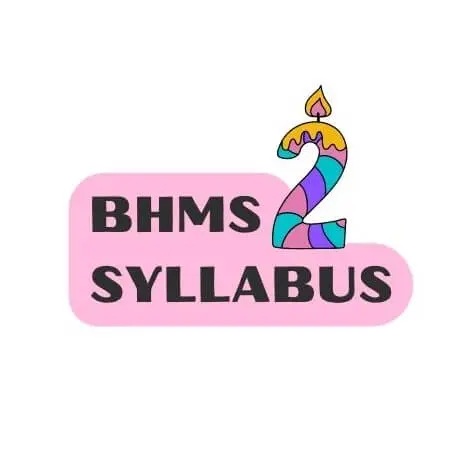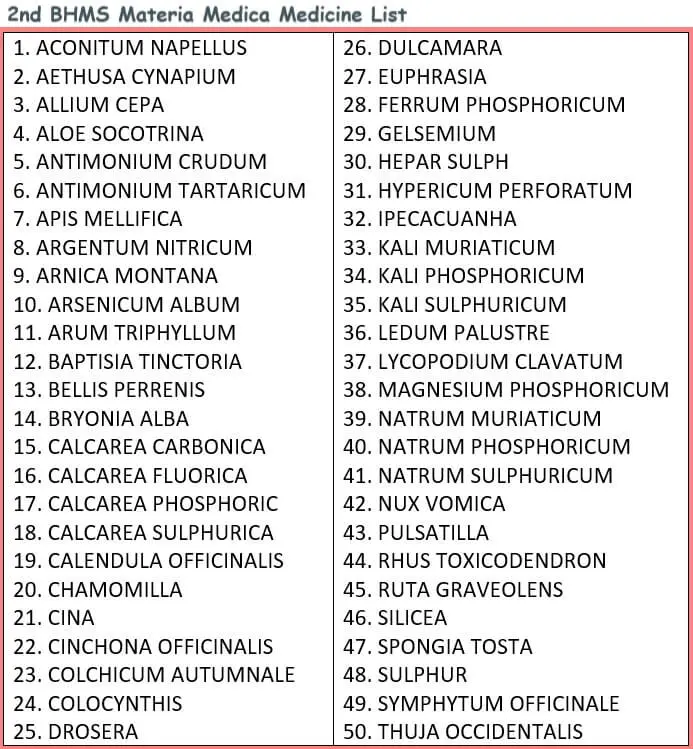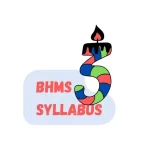
This post contains the whole syllabus of 2nd BHMS (Theory and Practical). This is prepared for the purpose of providing the whole idea of learning objectives in each subject.
This syllabus is applicable from the academic session 2015-2016, as per the guidelines of Central Council of Homoeopathy (India).
Subjects to be taught in 2nd BHMS
- Pathology, Microbiology and parasitology
- Forensic medicine & toxicology
- Organon of medicine
- Homoeopathic Materia medica
- Gynaecology and obstetrics
- Surgery
Before going through the detail, you should know that out of mainly 6 subjects you will have to give exam of only 4 subjects.
- Pathology, Microbiology and parasitology
- Forensic medicine & toxicology
- Organon of medicine
- Homoeopathic Materia medica
If you want to prepare for the University examination you should follow the below mentioned links,
Table of Contents
Toggle2nd BHMS PATHOLOGY SYLLABUS
Learning objectives
Students who are studying Pathology and microbiology should keep in mind that,
- At the end of the year, you should be able to understand the mechanisms of disease.
- Learn to recognize the abnormal signs and symptoms of the patient.
- Learn to form a differential diagnosis.
- Learn to apply laboratory methods to rule out the disease conditions.
- General concepts of the immunity along with diseases related to it should be given much importance.
- Learn to recognize the gross and histological tissue changes associated with diseases.
When Microbiology is concerned,
- Understand the relation of microbes in our daily lives.
- Study the main characteristics of micro-organisms that are clinically important.
- Learn to observe and measure microbial growth.
- Learn the aseptic techniques.
- Learn to prevent, diagnose and control of infections and disease conditions.
THEORY SYLLABUS
GENERAL PATHOLOGY
- Cell Injury and cellular adaptation
- Inflammation and repair (Healing).
- Immunity
- Degeneration
- Thrombosis and embolism
- Oedema
- Disorders of metabolism
- Hyperplasia and hypertrophy
- Anaplasia
- Metaplasia
- Ischaemia
- Haemorrhage
- Shock
- Atrophy
- Regeneration
- Hyperaemia
- Infection
- Pyrexia
- Necrosis
- Gangrene
- Infarction
- Amyloidosis
- Hyperlipidaemia and lipidosis
- Disorders of pigmentation
- Neoplasia (Definition, variation in cell growth, nomenclature and taxonomy, characteristics of neoplastic cells, aetiology and pathogenesis, grading and staging, diagnostic approaches, interrelationship of tumor and host, course and management).
- Calcification
- Effects of radiation
- Hospital infection
SYSTEMIC PATHOLOGY
In each system, the important and common diseases should be taught, keeping in view their evolution, aetio-pathogenesis, mode of presentation, progress and prognosis, namely:
- Mal-nutrition and deficiency diseases.
- Diseases of Cardiovascular system
- Diseases of blood vessels and lymphatics
- Diseases of kidney and lower urinary tract
- Diseases of male reproductive system and prostate
- Diseases of the female genitalia and breast.
- Diseases of eye, ENT and neck
- Diseases of the respiratory system.
- Diseases of the oral cavity and salivary glands.
- Diseases of the G.I. system
- Diseases of liver, gall bladder, and biliary ducts
- Diseases of the pancreas (including diabetes mellitus)
- Diseases of the haemopoetic system, bone marrow and blood
- Diseases of glands-thymus, pituitary, thyroid, and parathyroid, adrenals, parotid.
- Diseases of the skin and soft tissue.
- Diseases of the musculo-skeletal system.
- Diseases of the nervous system.
- Leprosy
MICROBIOLOGY
(I) General Topics
- Introduction
- History and scope of medical microbiology
- Normal bacterial flora
- Pathogenicity of micro-organisms
- Diagnostic microbiology
(II) Immunology
- Development of immune system
- The innate immune system
- Non-specific defense of the host
- Acquired immunity
- Cells of immune system; T cells and Cell mediated immunity; B cells and Humoral immunity
- The compliment system
- Antigen; Antibody; Antigen – Antibody reactions (Anaphylactic and Atopic); Drug Allergies
- Hypersensitivity
- Immuno-deficiency
- Auto-immunity
- Transplantation
- Blood group antigens
- Clinical aspect of immuno-pathology.
(III) Bacteriology
- Bacterial structure, growth and metabolism
- Bacterial genetics and bacteriophage
- Identification and cultivation of bacteria
- Gram positive aerobic and facultative anaerobic cocci, eg. Streptococci, Pneumococci.
- Gram positive anaerobic cocci, e.g., peptostreptococci
- Gram negative aerobic cocci, e.g., neisseria, moraxella, kingella.
- Gram positive aerobic bacilli, e.g., corynebacterium, aacillus anthrax, cereus subtitis, mycobacterium tuberculosis, M. leprae, actinomycetes; nocardia, organism of enterobacteriac group.
- Gram positive anaerobic bacilli, eg. genus clostridium, lactobacillus.
- Gram negative anaerobic bacilli, eg. bacteroides, fragilus, fusobacterium.
- Others like- cholerae vibrio, spirochaetes, leptospirae, mycoplasma, chlamydiae, rickettsiae, yersinia and pasturella.
(IV) Fungi and Parasites
- Fungi – (1) True pathogens (cutaneous, sub-cutaneous and systemic infective agents), (2) Opportunistic pathogens.
- Protozoa – (1) Intestinal (Entamoeba histolytica, Giardia lamblia, Cryptosporidum parvum), (2) Urogenital (Trichomonas vaginalis) 3) Blood and Tissues (Plasmodium-species, Toxoplasma gondii, Trypanosoma species, leishmania species).
- Helminths – (1) Cestodes (tapeworms)- Echinococcus granulosus, Taenia solium, Taenia saginata, (2) Trematodes (Flukes): Paragonimus westermani, Schistosoma mansoni, Schistosoma haematobium (3) Nematodes– Ancylostoma duodenale, Ascaris lumbricoides, Enterobius vermicularis, Strongyloides, Stercoralis, Trichuris trichiura, Brugia malayi, Dracunculus medinensis, Loa loa, Onchocerca volvulus, Wuchereria bancroftii.
(V) Virology
1.Introduction
2. Nature and classification of viruses
3. Morphology and replication of viruses
4. DNA viruses
- Parvo virus
- Herpes virus, varicella virus, cmv, ebv.
- Hepadna virus (hepatitis virus)
- Papova virus
- Adeno virus
- Pox virus- variola virus, vaccinia virus, molluscum contagiosum etc.
5. RNA viruses
- Orthomyxo virus: Entero virus, Rhino virus, Hepato virus
- Paramyxo virus- rubeola virus, mumps virus, influenza virus etc.
- Phabdo virus
- Rubella virus (german measles)
- Corona virus
- Retro virus
6. Yellow fever virus
7. Dengue, chikungunya virus
8. Miscellaneous virus
- Arena virus
- Corona virus
- Rota virus
- Bacteriophages
(VI) Clinical microbiology
(1) Clinically important micro-organisms
(2) Immunoprophylaxis,
(3) Antibiotic Sensitivity Test (ABST)
(VII) Diagnostic procedures in microbiology
(1) Examination of blood and stool
(2) Immunological examinations
(3) Culture methods
(4) Animal inoculation.
(VIII) Infection and Disease
(1) Pathogenicity, mechanism and control
(2) Disinfection and sterilization
(3) Antimicrobial chemotherapy
(4) Microbial pathogenicity
HISTOPATHOLOGY
- Teaching of histopathological features with the help of slides of common pathological conditions from each system.
- Teaching of gross pathological specimens for each system.
- Histopathological techniques, e.g., fixation, embedding, sectioning and staining by common dyes and stains.
- Frozen sections and its importance.
- Electron microscopy; phase contrast microscopy.
PRACTICAL SYLLABUS
(1) Clinical and chemical pathology: Estimation of haemoglobin (by acidometer), count of red Blood cells and white blood cells, bleeding time, clotting time, blood grouping, staining of thin and thick films, differential counts. Blood examination for parasites. Erythrocyte Sedimentation rate.
(2) Urine examination, physical, chemical microscopical, quantity of albumin and sugar.
(3) Examination of faeces: physical, chemical (occult blood) and microscopical for ova and Protozoa.
(4) Methods of sterilization, preparation of a media, use of microscope. Gram and acid-fast stains.
Motility preparation. Gram positive and negative cocci and bacilli. Special stains for Corynebacterium gram and acid-fast stains of pus and sputum.
(5) Preparation of common culture medias, e.g. nutrient agar, blood agar, Robertson ‘s Cooked Meal media (RCM) and Mac Conkey‘s media.
(6) Widal test demonstration.
(7) Exposure to latest equipment, viz. Auto-analyzer, cell counter, glucometer.
(8) Histopathology
- Demonstration of common slides from each system.
- Demonstration of gross pathological specimens.
- Practical or clinical demonstration of histopathological techniques, i.e., Fixation, embedding.
- Sectioning, staining by common dyes and stain. Frozen section and its importance.
- Electron microscopy, phase contrast microscopy.
2nd BHMS FORENSIC MEDICINE AND TOXIOCOLOGY SYLLABUS
Learning objectives
Students of 2nd BHMS who are studying forensic medicine should know that,
- Laws related to medical profession will be taught in this subject.
- Here you will be introduced with the legal procedures that are medico-legally very important.
- With the help of forensic science, you can learn how to collect, store and analyse all type of evidence.
- Forensic medicine subject helps to analyse the evidence collected from crime scenes.
- You will be able to identify the crime related cases in your medical practice.
- In toxicology, you will learn about the toxins that are medico-legally and medically important. You will be introduced with the various types of poisons and treatment related to it.
THEORY SYLLABUS
FORENSIC MEDICINE
- Introduction
- Definition of forensic medicine.
- History of forensic medicine in India.
- Medical ethics and etiquette.
- Duties of registered medical practitioner in medico-legal cases.
- Legal procedure
- Inquests, courts in India, legal procedure.
- Medical evidences in courts, dying declaration, dying deposition, including medical certificates, and medico-legal reports.
- Personal identification
- Determination of age and sex in living and dead; race, religion.
- Dactylography, DNA finger printing, foot print.
- Medico-legal importance of bones, scars and teeth, tattoo marks, handwriting, anthropometry.
- Examination of biological stains and hair.
- Death and its medico-legal importance
- Death and its types, their medico-legal importance
- Signs of death: Immediate, early, late and their medico-legal importance
- Asphyxial death (mechanical asphyxia and drowning).
- Deaths from starvation, cold and heat etc.
- Injury and its medico-legal importance
Mechanical, thermal, firearm, regional, transportation and traffic injuries; injuries from radiation, electrocution and lightening.
- Forensic psychiatry
- Definition; delusion, delirium, illusion, hallucinations; impulse and mania; classification of Insanity.
- Development of insanity, diagnosis, admission to mental asylum.
- Post-mortem examination (autopsy)
- Purpose, procedure, legal bindings; difference between pathological and medico-legal autopsies.
- External examination, internal examination of adult, foetus and skeletal remains.
- Impotence and sterility
Impotence; Sterility; Sterilisation; Artificial Insemination; Test Tube Baby; Surrogate mother.
- Virginity, defloration; pregnancy and delivery
- Abortion and infanticide
- Abortion: Different methods, complications, accidents following criminal abortion, MTP.
- Infant death, legal definition, battered baby syndrome, cot death, legitimacy.
- Sexual Offences
Rape, incest, sodomy, sadism, masochism, tribadism, bestiality, buccal coitus and other sexual perversions.
TOXICOLOGY
- General Toxicology
- Forensic Toxicology and Poisons
- Diagnosis of poisoning in living and dead,
- General principles of management of poisoning,
- Medico-legal aspects of poisons,
- Antidotes and types.
- Clinical Toxicology
Types of Poisons:
- Corrosive poisons (Mineral acids, Caustic alkalis, Organic acids, Vegetable acids)
- Irritant poisons (Organic poisons – Vegetable and animal; Inorganic poisons – metallic and non-metallic; Mechanical poisons)
- Asphyxiant poisons (Carbon monoxide; Carbon dioxide; Hydrogen sulphide and some war gases)
- Neurotic poisons (Opium, Nux vomica, Alcohol, Fuels like kerosene and petroleum products, Cannabis indica, Dhatura, Anaesthetics Sedatives and Hypnotics, Agrochemical compounds, Belladonna, Hyoscyamus, Curare, Conium)
- Cardiac poisons (Digitalis purpurea, Oleander, Aconite, Nicotine.
- Miscellaneous poisons (Analgesics and Antipyretics, Antihistaminics, Tranquillisers, antidepressants, Stimulants, Hallucinogens, Street drugs etc).
- Legislations relating to medical profession
- The Homoeopathy Central Council Act, 1973 (59 of 1973);
- The Consumer Protection Act, 1986 (68 of 1986);
- The Workmen ‘s compensation Act, 1923 (8 of 1923);
- The Employees State Insurance Act, 1948 (34 of 1948);
- The Medical Termination of Pregnancy Act, 1971 (34 of 1971);
- The Mental Health Act, 1987 (14 of 1987);
- The Indian Evidence Act, 1872 (1 of 1872);
- The Prohibition of Child Marriage Act, 2006 (6 of 2007);
- The Personal Injuries Act, 1963 (37 of 1963)
- The Drugs and Cosmetics Act, 1940 (23 of 1940) and the rules made therein;
- The Drugs and Magic Remedies (Objectionable Advertisements) Act, 1954 (21 of 1954);
- The Transplantation of Human Organs Act, 1994 (42 of 1994);
- The Pre-natal Diagnostic Techniques (Regulation and Prevention of Misuse) Act, 1994 (57 of 1994);
- The Homoeopathic Practitioners (Professional Conduct, Etiquette and Code of Ethics) Regulations, 1982;
- The Drugs Control Act, 1950 (26 of 1950);
- The Medicine and Toiletry Preparations (Excise Duties) Act, 1955 (16 of 1955);
- The Indian Penal Code (45 of 1860) and the Criminal Procedure Code (2 of 1974) (relevant provisions)
- The Persons with Disabilities (Equal Opportunities, Protection of Rights and Full Participation) Act, 1995 (1 of 1996);
- The Clinical Establishment (Registration and Regulation) Act, 2010 (23 of 2010).
PRACTICAL SYLLABUS
- Demonstration
- Weapons
- Organic and inorganic poisons
- Poisonous plants
- Charts, diagrams, photographs, models, x-ray films of medico-legal importance
- Record of incidences reported in newspapers or magazines and their explanation of medicolegal importance.
- Attending demonstration of ten medico-legal autopsies.
- Certificate Writing
Various certificates like sickness certificate, physical fitness certificate, birth certificate, death certificate, injury certificate, rape certificate, chemical analyzer (Regional Forensic Laboratory), certificate for alcohol consumption, writing post-mortem examination report.
2nd BHMS MATERIA MEDICA SYLLABUS
If you are a 2nd BHMS student, you should have an idea that you will have to appear for the Materia Medica examination for the first time.
1st BHMS Materia medica syllabus also will be included in the exam.
If you want to prepare for your university examination, follow the below mentioned link… 2nd BHMS MATERIA MEDICA EXAM QUESTIONS.
THEORY SYLLABUS
In addition to syllabus of First B.H.M.S. Course, following topics shall be taught, namely:
- Science and philosophy of homoeopathic Materia medica.
- Different ways of studying homoeopathic Materia medica (e.g., psycho-clinical, pathological, physiological, synthetic, comparative, analytical, remedy relationships, group study, portrait study etc.)
- Scope and limitations of homoeopathic Materia medica.
- Concordance or remedy relationships.
- Comparative homoeopathic Materia medica, namely: Comparative study of symptoms, drug pictures, drug relationships.
- Theory of biochemic system of medicine, its history, concepts and principles according to Dr. Wilhelm Heinrich Schuessler. Study of 12 biochemic medicines. (Tissue remedies).
Homoeopathic Medicines to be taught in Second B.H.M.S as follows,

2nd BHMS ORGANON SYLLABUS
Just like Materia medica, you will have to appear for Organon of medicine university examination for the first time in 2nd BHMS.
1st BHMS year syllabus will also include in the examination.
The syllabus of 2nd BHMS is the continuation of the theories and aphorisms that you already have learned in 1st BHMS.
If you want to prepare for your university examination, follow the below mentioned link, 2nd BHMS ORGANON IMPORTANT EXAM QUESTIONS.
THEORY SYLLABUS
- Aphorisms 29-104 including foot notes of Organon of Medicine (5th & 6th Editions translated by R.E. Dudgeon and W. Boericke).
- Homoeopathic philosophy:
- Chapters of Philosophy books of J.T. Kent (Chapters 1 to17, 23 to 27, 31 to 33), Stuart Close (Chapters- 8,9, 11, 12) and H.A. Roberts (Chapters3,4,5,6, 8, 9, 11, 17, 18, 19,20), related to Aphorisms 29-104 of Organon of Medicine Symptomatology: Details regarding Symptomatology are to be comprehended by referring to the relevant aphorisms of organon of medicine and chapters of the books on homoeopathic philosophy.
- Causations:
Thorough comprehension of the evolution of disease, taking into account pre-disposing, fundamental, exciting and maintaining causes.
- Case taking:
The purpose of homoeopathic case taking is not merely collection of the disease symptoms from the patient, but comprehending the patient as a whole with the correct appreciation of the factors responsible for the genesis and maintenance of illness. Hahnemann ‘s concept and method of case taking, as stated in his Organon of Medicine is to be stressed upon.
- Case processing: This includes,
- Analysis of Symptoms,
- Evaluation of Symptoms,
- Miasmatic diagnosis,
- Totality of symptoms
PRACTICAL OR CLINICAL SYLLABUS
- Clinical posting of students shall be started from Second B.H.M.S onwards.
- Each student shall maintain case records of at least ten acute cases.
2nd BHMS SURGERY SYLLABUS
There shall be no examination of Surgery in second BHMS.
You can find 3rd BHMS Surgery syllabus by following the link.
General Surgery
- Introduction to surgery and basic surgical principles.
- Fluid, electrolytes and acid-base balance.
- Haemorrhage, haemostasis and blood transfusion.
- Boil, abscess, carbuncle, cellulitis and erysipelas.
- Acute and chronic infections, tumours, cysts, ulcers, sinus and fistula.
- Injuries of various types; preliminary management of head injury
- Wounds, tissue repair, scars and wound infections.
- Special infections (Tuberculosis, Syphilis, Acquired Immuno Deficiency Syndrome, Actinomycosis, Leprosy).
- Burn
- Shock
- Nutrition
- Pre-operative and post-operative care.
- General management, surgical management and HOMOEOPATHIC therapeutics of the above topics covered.
2nd BHMS GYNECOLOGY AND OBSTETRICS SYLLABUS
There shall be no examination of Gynaecology and Obstetrics in second BHMS.
Follow the link for 3rd BHMS Gynaecology and Obstetrics syllabus.
Gynaecology
- A review of the applied anatomy of female reproductive systems development and malformations.
- A review of the applied physiology of female reproductive systems-puberty, menstruation and menopause.
- Gynaecological examination and diagnosis.
- Developmental anomalies.
- Uterine displacements.
- Sex and intersexuality.
- General Management and therapeutics of the above listed topics in Gynaecology.
Obstetrics
- Fundamentals of reproduction.
- Development of the intrauterine pregnancy-placenta and foetus.
- Diagnosis of pregnancy-investigations and examination.
- Antenatal care.
- Vomiting in pregnancy.
- Preterm labour and post maturity.
- Normal labour and puerperium.
- Induction of labour.
- Postnatal and puerperal care,
- Care of the new born.
- Management and therapeutics of the above listed topics in obstetrics.













Very detailed and usefull material.